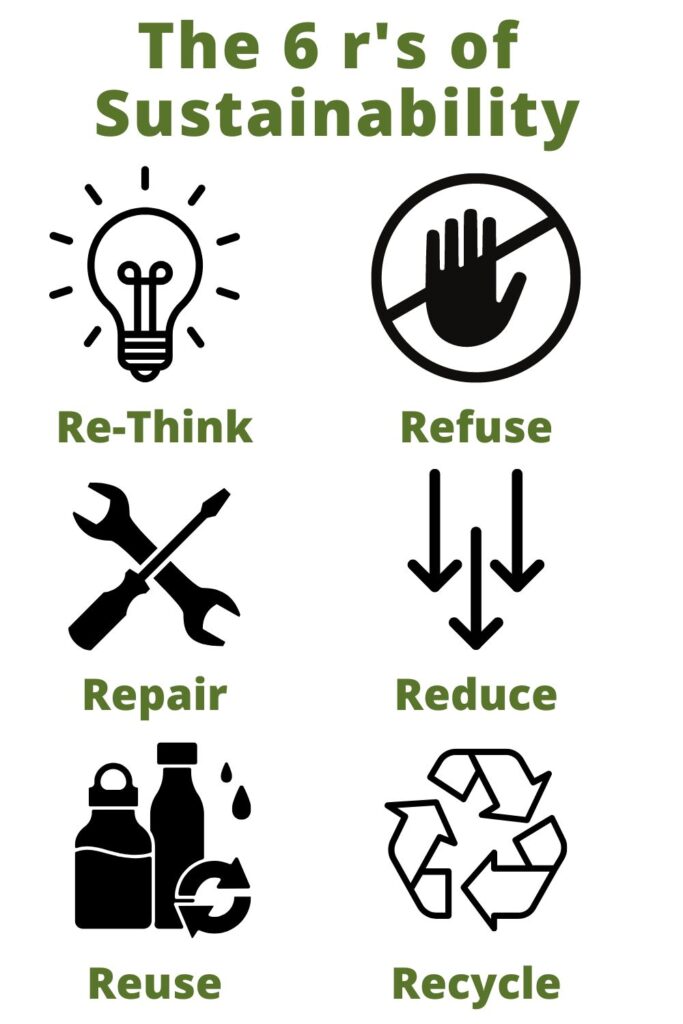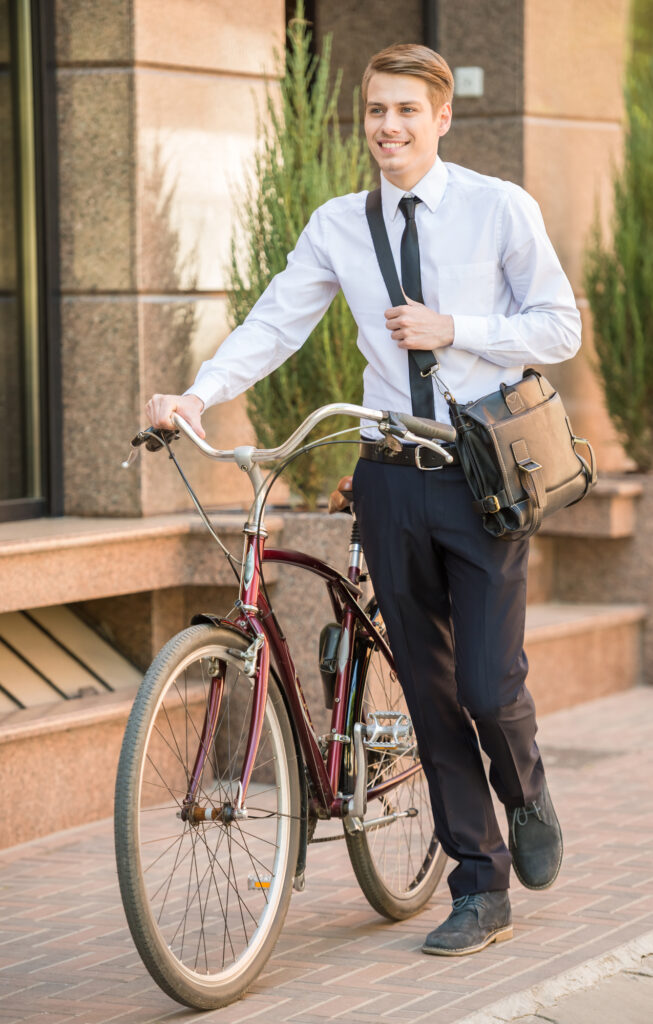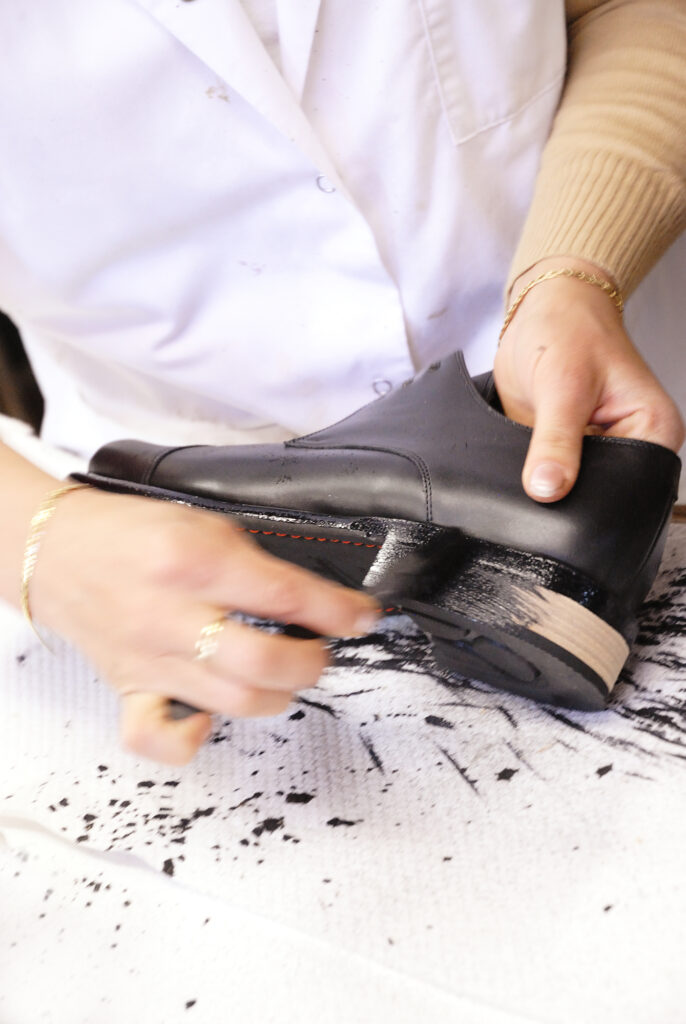For decades we have encouraged the ideas of reducing, reducing, and recycling our way to a greener and more sustainable future. But I want to challenge you to go further. The 6 rs of sustainability are Rethink, Refuse, Reduce, Reuse, Recycle, Repair. And adopting each one of these ideas in different aspects of our lives will help us create a greener future, one baby step at a time.
Let me just clarify that while a zero-waste lifestyle is a lofty goal, just learning to live a simple, sustainable life and reducing your consumption habits is also a great goal. Future generations need progress, not perfection when it comes to the changes we make in our daily life.
Posts feature partner companies & may be sponsored. Post contains affiliate links & I will be compensated if you make a purchase after clicking on links. As an Amazon Associate I earn from qualifying purchases.

Table of Contents
What are the 6 rs of sustainability?
Meeting the needs of humanity without destroying the planet we live on is a vital, yet challenging, goal. Only if we address the complex issues of environmental change from multiple angles will we find a solution that works for everyone.
Here is a breakdown of the 6 rs of sustainability and how YOU as an individual can play a part in achieving a more sustainable life.

✯Don’t want to miss the next post?✯
Follow Turning the Clock Back on Facebook | Twitter | Pinterest
Or join the private Facebook group for simple tips on going green!
Rethink
The first R is for rethink. And that’s just what we need to do. We need to rethink the way we live our lives and what we pay money for. Common examples of things we should rethink are the way we consume goods and services and the way we get around. What do we value in our search for happiness?
Do we really need to use a car for every single trip? Let’s find a more sustainable way to get from one place to another in this world. Can we walk, ride our bikes or take public transport instead? (check out my thoughts on eco-friendly transportation!)
Let’s rethink the way we produce goods and services. Are there more sustainable ways of doing things? Does everything we buy need to be wrapped in plastic packaging? What raw materials are being used to make the things we buy?
How do we consume goods and services? Do we really need that new gadget? Can we repair or reuse the one we have instead of buying a new one?
What things do we value? The latest fashion trends? The newest car model? Our stuff? Or do we value experiences, relationships, family, friends, and community?
All of these things need to be taken into account when we rethink the way we live. And it’s not just about changing our personal habits.
We need to change the systems we have in place. The systems that encourage and enable unsustainable habits. We need to change the way our economy works. The way our businesses operate. The way our governments make decisions. That’s a tall order for our society.
But for our planet to thrive, we need to rethink everything. Whether you take personal action by rethinking your own life choices or get involved in helping your community reimagine change on a larger scale, there are plenty of ways to get involved in the process. (read my post about how to start a food co-op in your community!)

Refuse
The second R in the 6 rs of sustainability is for refuse. And this one is pretty straightforward. We need to stop accepting things that are harmful to the environment.
We need to stop using single-use plastics and disposable coffee cups. And even though it is a small step, we need to stop using plastic straws and single-use water bottles. And we need to stop using plastic cutlery and plastic toothbrushes.
Arm yourselves with reusable alternatives that are easy to pack and have on hand when you are out and about. That way, when offered something disposable, you can easily REFUSE it and throw away one less thing.
Here are a few reusable travel options to pack with you to replace single-use products:
- Travel Utensil Sets of Wheat Straw Reusable Cutlery: An excellent alternative to plastic and can be used multiple times.
- Stainless Steel Vacuum Insulated Coffee Cup: Ideal for shakes, smoothies or coffee. Comes with a straw brush and upgraded pop-up lid for super easy cleaning!
- Reusable Collapsible Stainless Steel Straw with Case: Made of food-grade 304 stainless steel.
These are just the most common examples of the things we need to stop using if we want to create a greener future. We need to refuse the things that are harmful to the environment. Even if all you do is say no thanks to the plastic bag for your most recent purchase, it’s one step in the right direction.

Reduce
The third R in the 6 r’s of sustainability is for reduce. We need to reduce the amount of stuff we use, have, and buy.
For example, we need to reduce the amount of water we use. The average person uses 176 gallons of water a day. That’s a lot of water! And a lot of it is wasted. We need to be more conscious of the water we use and find ways to use less of it.
To be truly environmentally conscious, we need to reduce the amount of energy we use. The average person uses 893 kilowatt-hours of electricity a month according to the US EPA. That’s a lot of electricity! And a lot of it is wasted. We need to be more conscious of the electricity we use and find ways to use less of it to reduce climate change. (check out my post on reducing energy usage at home)
We need to reduce the amount of gas we use. The average person uses 949 gallons of gas a year. That’s a lot of gas! And a lot of it is wasted. We need to be more conscious of the gas we use and find ways to use less of it. And while it is easy to think ‘Oh, I’ll get an electric car.’, these also use an extensive amount of resources to create and power.
You can do your part by reducing what you waste. The average person wastes 250 pounds of food a year. Learn a few food waste reduction tips and take action. Reuse food scraps by starting a compost heap.
Composting food scraps will not only reduce waste but those organic materials, once broken down into compost, are wonderful for your garden. Less waste in the landfill, free soil amendments for you! Just make sure you check out my list of noncompostable items before you get started.
Invest in a solar battery charger or wear your clothes more than once before washing them. There are dozens of steps that each individual can take to reduce their carbon footprint.

Reuse
The fourth R in the 6 rs of sustainability is for reuse. We need to find ways to reuse the things we have to reduce our carbon footprint.
We need to reuse our clothes. The average person buys 64 items of clothing a year. That’s a lot of clothes! for a significantly more sustainable lifestyle, shop secondhand. Buying second-hand is a great way to reuse clothes. And if you have old clothes that are too worn to be donated, try upcycling them into blankets, pillows, or other items so you don’t produce more waste.
Upcycled crafts are another great way to reuse things. You can make a lot of things out of recycled materials. Here are a few upcycled craft ideas to try:
Before you throw something away, ask yourself if there is a way to reuse it. Look at the things you throw away and ask yourself if it has an alternative use. Use egg cartons to sprout seeds or empty glass jars for pantry storage. Turn your food waste into compost for the garden. If you have a reuse idea, I’d love to hear it!

Recycle
The fifth R is for recycle. We need to recycle the things we can’t reuse. Depending on where you live, this may be easier for some than others. However, just because your curbside recycling bin doesn’t accept something, doesn’t mean there are no recycling resources nearby for you to use.
Here are a few staggering facts about human consumption of goods:
- The average person uses 1,500 pounds of paper a year.
- The average person uses 185 pounds of plastic a year.
- Americans dispose of some 10 million metric tons of glass annually.
These are just some examples of the things we need to recycle to ensure that they stay out of landfills.
But remember, recycling by itself is not a solution to our waste problems as a society. Even if we recycled all the items we could, society could not achieve true sustainability. All of the 6 r’s of sustainability need to be considered.

Repair
The sixth and final R is for repair. Basically, we need to repair broken things so we stop using so many natural resources to make NEW things.
We need to find ways to repair our clothes so we can keep them out of landfills. We need to repair our appliances. And we need to stop seeing things like furniture, shoes, and electronics as single use items.
If you own something that breaks, search for someone to fix it. From shoe repair shops to fixing an old computer instead of sending it to the landfill, there are many options out there to repair broken items instead of buying new items to replace them.
Check out my post about the lost art of mending socks and how to reuse them when you can’t.

The three pillars of sustainability
In addition to the 6 rs of sustainability, there is an overarching concept of the three pillars of sustainability. The three pillars of sustainability are often represented as a triangle where money, people, and the environment are all part of a global sustainable lifestyle.
People: The social pillar
The first pillar is people. And this one is pretty straightforward. We need to take care of people. We need to make sure that everyone has the resources they need to live a healthy and productive life.
This means providing access to things like clean water, food, shelter, education, and healthcare. It also means creating opportunities for people to earn a livable wage.
A company’s ethics should be important when choosing where to spend your money. Do they care for their employee’s well-being? If not, reconsider your purchase.
Planet: The environmental pillar
The second pillar is the planet. We need to take care of our planet. We need to make sure that we are using resources in a way that is sustainable and that we are not causing irreparable harm to the environment.
This means things like reducing our greenhouse gas emissions, protecting biodiversity, and conserving natural resources.
It also means that the byproducts the company produces should not end up in a landfill. Choose companies that work to reduce waste, and make new things out of recycled goods.
Profit: The economic pillar
The third pillar is profit. And this one is a little bit more controversial. Some people believe that profit should be the primary goal of businesses and that sustainability should take a back seat. However, there is a growing movement of people who believe that businesses need to be profitable AND sustainable in order to be truly successful.
Balancing profit with concern for people and the planet is vital if corporate interests are going to be met. The UN’s sustainable development goals are a great example of how businesses can focus on profit while also taking care of people and the planet.
The Bottom Line
The three pillars of sustainability are interdependent. We can not have a sustainable future without taking care of people and the planet.
And we can not take care of people and the planet without businesses being profitable.
It is only when all three pillars are given an equal weight that we can hope to achieve a sustainable future.

Final Thoughts on the 6 rs of sustainability
Humans have had a rather devastating effect on the environment. From the Great Pacific Garbage Patch to climate change, the signs are all around us. We need to change our habits if our planet is going to survive.
In recent years, there has been greater societal awareness of sustainability. However, it seems like most of the push has been for people to recycle or pay money for energy-efficient cars. While those things are important, our focus should not just be on the ‘reduce reuse recycle’ part of the equation.
True change will only occur when we consider the 6 r’s of sustainability and the 3 pillars of sustainability throughout most of our life.
And remember, a zero waste life is great but not required in most cases. From sustainable development in cities to encouraging most people to search for eco-friendly alternatives in their everyday life, look at both the big picture, as well as the small changes you can make on a personal level. Only then can true sustainability be achieved.
And let me just at one more R to this post. Re-imagine. Because only when we take time to re-imagine a better future will be begin to truly work hard to achieve it.

Diane is a professional blogger and nationally certified pharmacy technician at Good Pill Pharmacy. She earned her BS in Microbiology at the University of New Hampshire and has worked in cancer research, academics, and biotechnology. Concern over the growing incidence of human disease and the birth of her children led her to begin living a more natural life. She quickly realized that the information she was learning along the way could be beneficial to many others and started blogging and freelance writing to share this knowledge with others. Learn more about her HERE.
